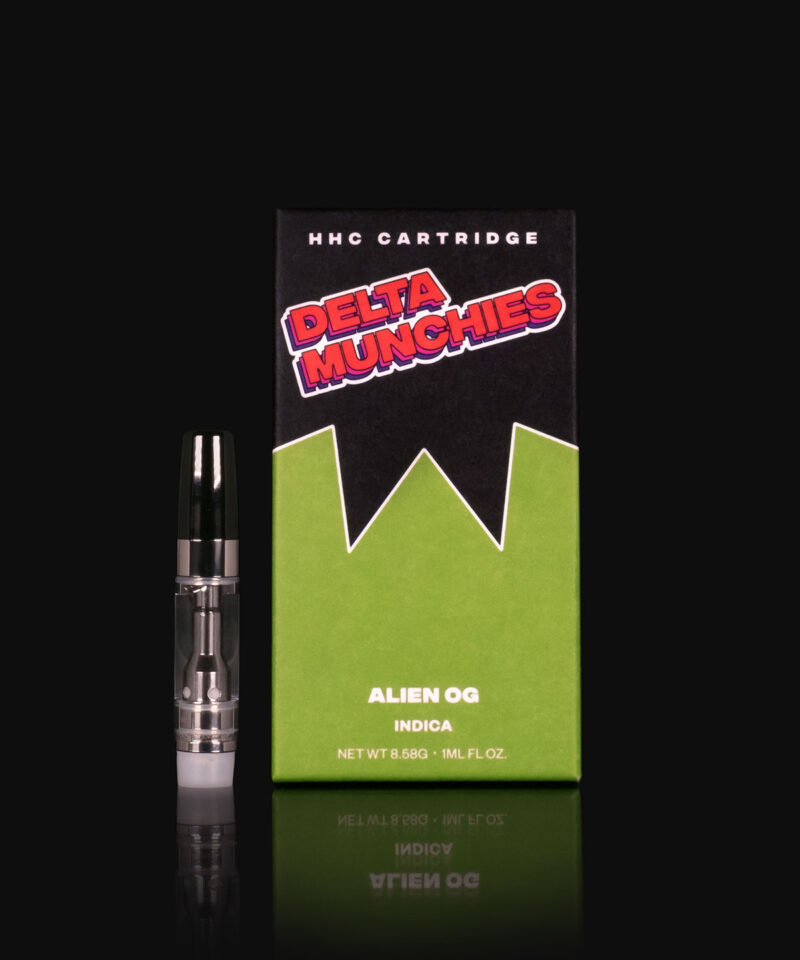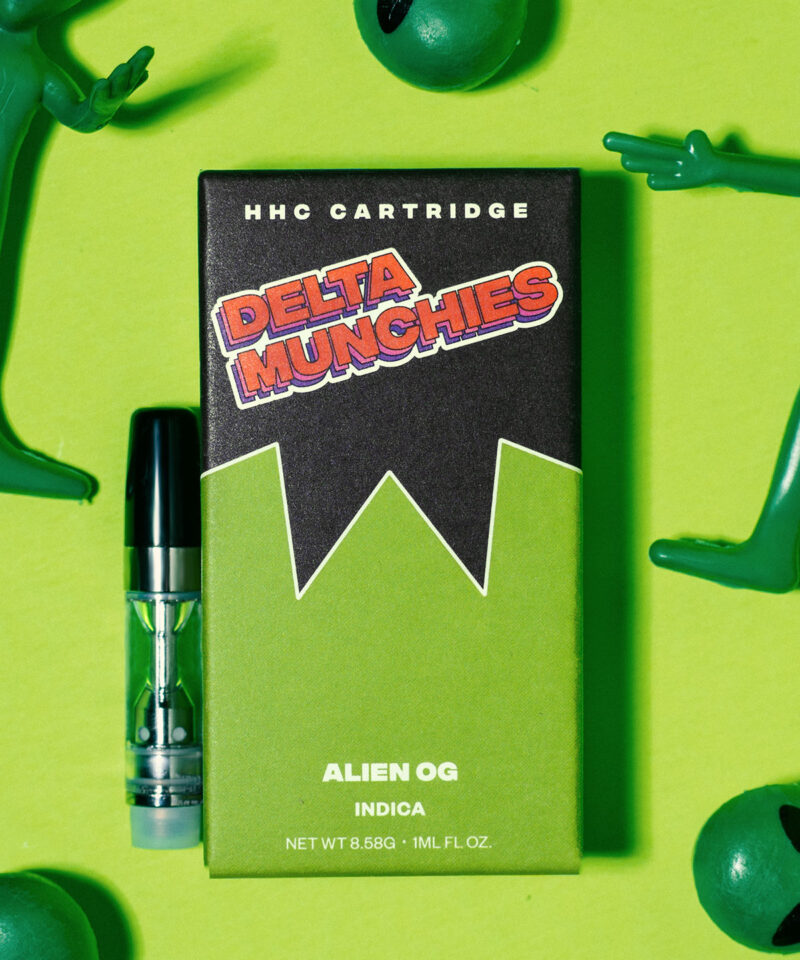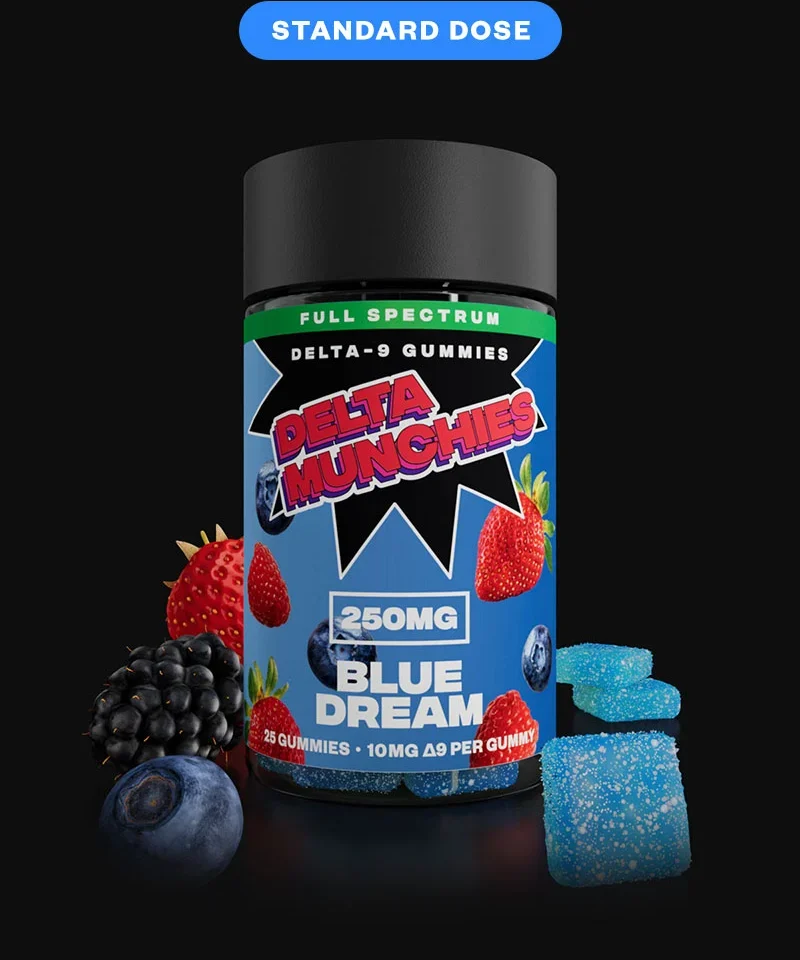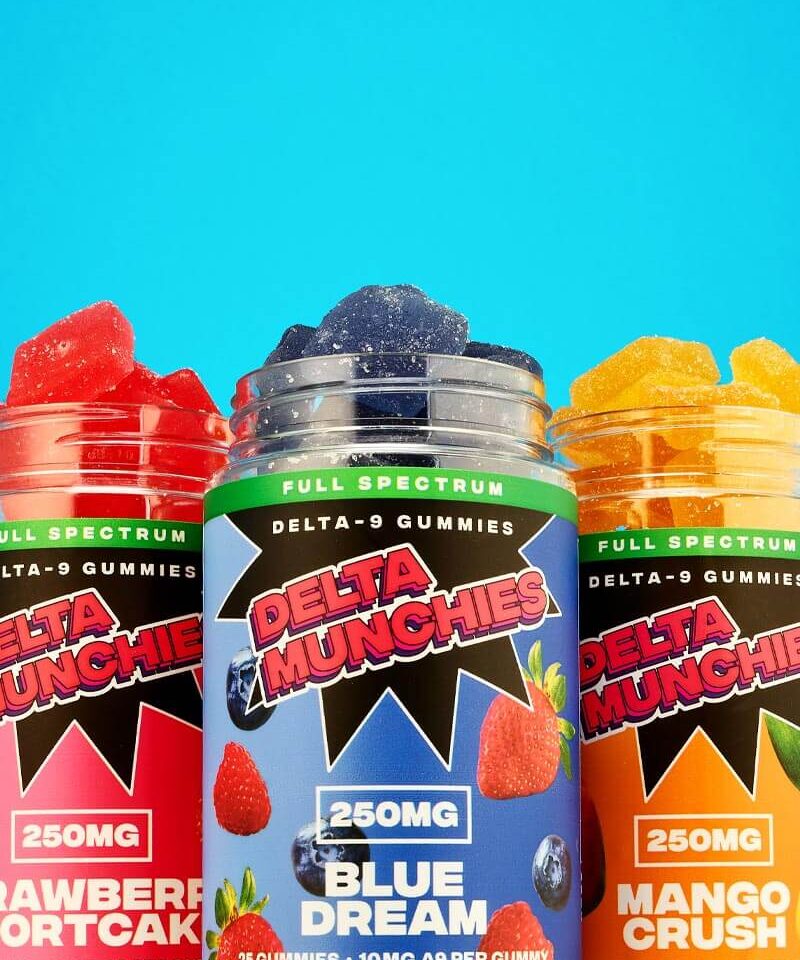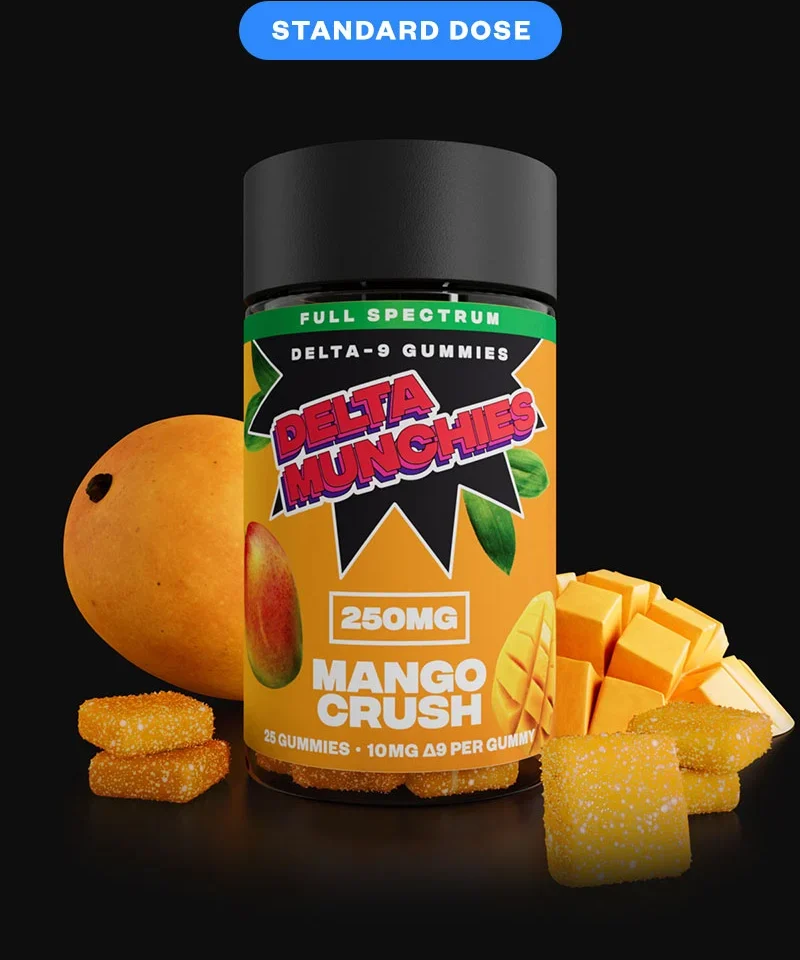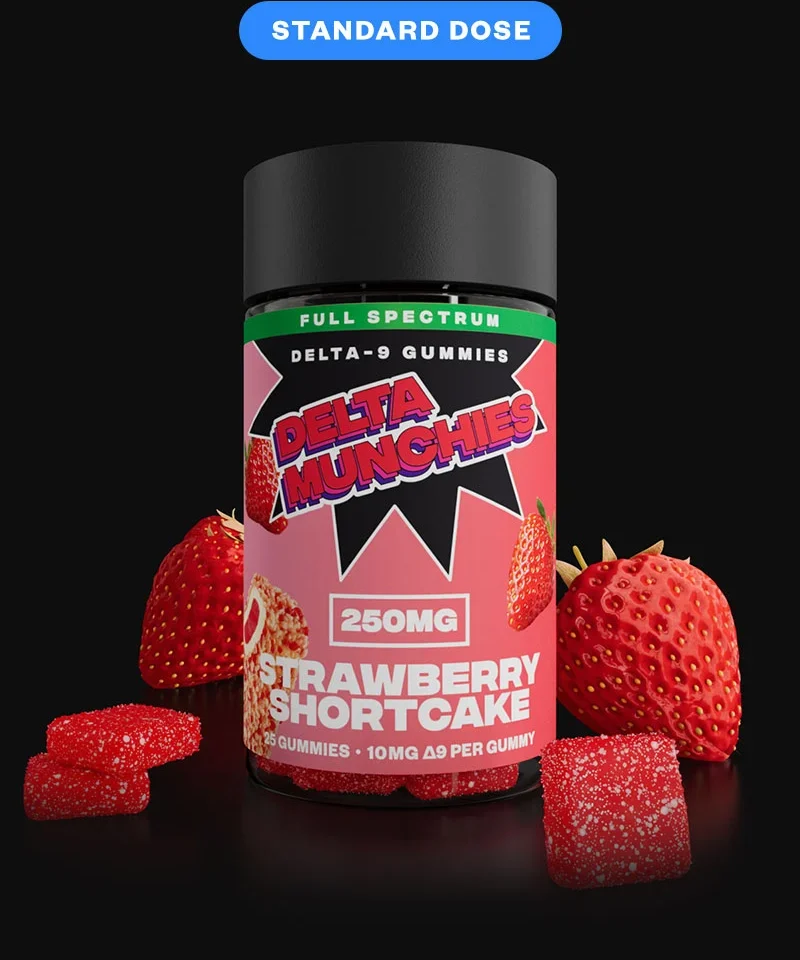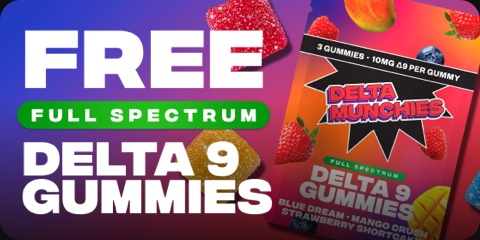Alternative Cannabinoids, Delta 10, Delta 8, Delta 9, HHC, Informative
The Best Cannabinoids to Get High
Here at Delta Munchies, we’re no stranger to “alternative cannabinoids,” or cannabinoids other than standard delta 9 THC. As the cannabis industry continues to pick up on how useful the other cannabinoids that the cannabis plant provides are (such as delta 8, delta 10, HHC, and others), the market for consumers is getting flooded with cannabinoid-laden products that not everyone may be familiar with.
Since more cannabinoids are being introduced to the mainstream cannabis market each year, it’s important for consumers to know which cannabinoids are the best cannabinoids to get high. Which cannabinoids are psychoactive? Which cannabinoids are non-psychoactive? What are synthetic cannabinoids? Are synthetic cannabinoids safe?
There is an incredible amount to know about the complex world of cannabinoids, so come with us to find out which cannabinoids are the best cannabinoids for you!
Looking for potent cannabinoids? Check out our strongest products!
Delta 9 THC
Contents
- Key Takeaways
- What Are Cannabinoids?
- How Many Cannabinoids Are There?
- Most Popular Cannabinoid Acids
- Common Plant Cannabinoids
- CBG (Cannabigerol)
- THC (tetrahydrocannabinol)
- CBD (Cannabidiol)
- CBC (Cannabichromene)
- CBGV (Cannabigerivarin)
- THCV (Tetrahydrocannabivarin)
- CBDV (Cannabidivarin)
- CBCV (Cannabichromevarin)
- What Cannabinoids Are Psychoactive?
Key Takeaways
- Not all cannabinoids have the same effects, hence not all of them will make you high.
- The most psychoactive cannabinoids are delta 9 THC, delta 8 THC, and HHC.
- Delta Munchies is the finest purveyor of psychoactive cannabinoids in the US.
What Are Cannabinoids?
Cannabinoids are chemical compounds that are found in nature that have been cultivated by humans for consumption for quite literally thousands of years.
The human body also contains a naturally-occurring system called the endocannabinoid system (or the ECS). The endocannabinoid system includes two different types of cannabinoid receptors, CB1 (or cannabinoid receptors type 1) and CB2 (or cannabinoid receptors type 2). These cannabinoid receptors exist within the nervous system and immune system, respectively.
Cannabinoids can be separated into two different groups: phytocannabinoids and endocannabinoids. Both cannabinoids are found in nature, but phytocannabinoids are cannabinoids found in the cannabis and hemp plants, while endocannabinoids are cannabinoids that are produced by the human body. However, the cannabinoids that we are the most familiar with are phytocannabinoids, such as THC, CBD, and more.
THC (tetrahydrocannabinol) and CBD (cannabidiol) are the most well-known cannabinoids found in weed, but as cannabis continues to legalize in more states across the United States, cannabinoid scientists and researchers have been able to identify more than 100 unique cannabinoids found inside the cannabis and hemp plants. And there may be even more! Years of marijuana prohibition have stunted cannabis research, but with ongoing legality, innovations, and discoveries in cannabis science, more cannabinoids are sure to be discovered.
What Are Cannabinoids and Terpenes?
Plant-based cannabinoids typically come along with terpenes, which are chemical compounds that are responsible for the way many different plants smell. (Which means yes, we can thank terpenes for that distinct skunky weed smell!)
Terpenes in weed usually show up as crystalized pieces on the ends of the marijuana leaves and are an extremely coveted trait when it comes to cannabis users looking for high-quality bud.
What Are Phytocannabinoids?
Phytocannabinoids enter our system in two ways: via smoking weed or via ingesting infused food or drink. When we smoke cannabis, the cannabinoids are inhaled through our lungs, absorbed through our bloodstream, and carried to the brain, where they’re distributed to the cannabinoid receptors throughout the body.
Alternatively, when we eat edibles, the cannabinoids are digested through the stomach, metabolized by the liver, and then dispersed through the bloodstream, where they’re distributed to our cannabinoid receptors. (Fun fact: That’s why edibles take so much longer to kick in!) Once the cannabinoids reach our cannabinoid receptors, their interaction produces the physical and mental feelings and effects we’ve come to associate with cannabis.
Phytocannabinoids are also commonly referred to as “plant-based” cannabinoids as their defining trait is that these cannabinoids are found exclusively in the cannabis and hemp plants. But wait, aren’t all cannabinoids found inside cannabis? As it turns out, the human body doesn’t just have a built-in cannabinoid system to process cannabinoids from weed, but because the human body actually creates cannabinoids itself.
What Are Endocannabinoids?
Endocannabinoids are cannabinoids that are created by the human body. The discovery of endocannabinoids was actually relatively recent; it wasn’t until the 1990s that cannabis scientists discovered naturally produced cannabinoids in the human brain.
Endocannabinoids are sometimes called endogenous cannabinoids and are lipid-based neurotransmitters that carry chemical messages throughout the body. Endocannabinoids send signals between nerve cells and help with various bodily functions.
There have been two main endocannabinoids identified thus far:
- AEA (or arachidonoyl ethanolamide)
- 2-AG (or 2-archidonoyl glyerol)
Similar to phytocannabinoids, the research done on endocannabinoids is still relatively young, meaning that scientists believe there is a great chance that other endocannabinoids may be discovered in the future.
What Are Synthetic Cannabinoids?
Synthetic cannabinoids are cannabinoids created by human scientists in a lab. Most people when talking about synthetic cannabinoids are talking about dangerous, fake strains of cannabis. These are sprayed with toxic chemicals to replicate the high that would normally come from cannabinoids and can be extremely detrimental to human health, and in some cases, can even be lethal.
However, there are some forms of synthetic cannabinoids that are not unsafe. Scientists can recreate natural processes in a lab to create cannabinoids that would already exist in nature. This means that some forms of HHC are considered synthetic because the chemical reaction to create HHC is facilitated in a lab. However, that doesn’t mean that all synthetic cannabinoids are unsafe. Some cannabinoids exist within a grey area called semi-synthetic cannabinoids, which has sparked some debate within the cannabis community about what constitutes a synthetic cannabinoid or not.
What Are Semi-Synthetic Cannabinoids?
Semi-synthetic cannabinoids technically aren’t a scientific class the way phytocannabinoids, endocannabinoids, and synthetic cannabinoids are. Instead, the term ‘semi-synthetic’ has been used to describe cannabinoids that would still exist in nature even if human intervention didn’t exist.
For example, HHC (or hexahydrocannabinol) is the result of THC when a hydrogen molecule is added to it. Since hydrogen molecules are organically found in nature, humans aiding the process of the chemical reaction has prompted some people to adopt the term ‘semi-synthetic’ cannabinoids.
What Are the Side Effects of Cannabinoids?
Because we all have completely different genes, physiological makeup, and biological predispositions, cannabinoids and their effects will differ for each individual person. Two different people could consume the same amount of cannabis in the same way yet have two completely different experiences.
There are many different factors that go into how cannabinoids will affect you, including:
- Height, weight, and body mass. The taller or larger you are, typically the more of a substance your body will be able to absorb before feeling the effects. Alcohol is a great example; those who are smaller in body mass will only need a drink or two to feel the same effects that a larger person would feel after five or six drinks.
- As we age, our body undergoes a plethora of changes, including how we react to certain substances. Additionally, our organs age, which means that the lungs and liver (the two organs that absorb cannabinoids when they’re ingested) may degrade to a point where they can no longer appropriately metabolize cannabinoids.
- Tolerance or experience. The more experienced cannabis user you are, the higher your tolerance is likely to be. A cannabis tolerance can develop after heavy and/or frequent use of marijuana. The more weed you smoke, the more you’ll need to get high. The same goes for edibles; the more you work your way up in dosages, the higher you’ll need to go to get, well, higher.
- Method of consumption. Although a cannabis tolerance can develop no matter which method of consumption you choose, there is a big difference in how methods of consumption will affect you in the short term. Methods of consumption such as smoking or vaping hit fast and strong. When you smoke weed, the cannabinoids are absorbed through the lungs and spread throughout the body via the bloodstream. This causes an instantaneous high that usually lasts anywhere from 30 minutes to a couple of hours.
On the other hand, methods of consumption such as taking edibles or tinctures will take a lot longer to kick in, but when they do, they last for a long time. When we take edibles, we first digest them through the stomach and then metabolize them through the liver. This process can take anywhere from 1 to 3 hours to fully take place, but once it does, the effects are nearly three times as strong as vaping or smoking.
- Medications or preexisting conditions. Certain medications and preexisting conditions may affect how cannabis and its cannabinoids affect you. (Disclaimer: if you are concerned about how marijuana may affect any current medication you may be on or any preexisting conditions you may have, PLEASE speak to your primary care physician. We are NOT giving medical advice!)
- Overall health. To reap the benefits of cannabinoids, the body has to metabolize them first. This means that the faster your metabolism is, the easier time your body will have accepting and metabolizing cannabinoids. This can drastically alter how cannabis affects you depending on how your own personal health is taken care of.
How Many Cannabinoids Are There?
Currently, there have been over 100 unique cannabinoids discovered within the cannabis plant, but only two have been identified within the human body.
How Many Cannabinoids in Weed
There are currently over 100 known cannabinoids that can be found inside the cannabis and hemp plants. In the United States, marijuana was prohibited on a federal level for almost 100 years, making cannabis research almost impossible for a very long time. Because of expanding legality across the U.S., more cannabis research is becoming accessible to scientists, meaning that more cannabinoids are being discovered. This means that the more we look into cannabis, the more cannabinoids we may find!
Most Popular Cannabinoid Acids
The precursors to cannabinoids are cannabinoid acids. Cannabinoids start chemically in an acidic form before they undergo some sort of chemical interaction which turns them into the cannabinoid chemical compounds that we’re more familiar with.
CBGA (Cannabigerolic Acid)
CBGA or (cannabigerolic acid) is commonly referred to as the “mother of all cannabinoids” as this is the initial building block to many other cannabinoids such as THC and CBD. But before CBGA undergoes the chemical reactions necessary to turn it into other cannabinoids, the presence of the cannabinoid acid helps to protect and conserve the plant’s energy.
THCA (Tetrahydrocannabinolic Acid)
THCA (or tetrahydrocannabinolic acid) is the most abundant cannabinoid found in the raw cannabis plant. THCA turns into THC once it’s decarboxylated, which means heated to the point of near combustion. THCA is not psychoactive until it turns into THC, but some cannabis researchers have said there are some potential benefits to consuming THCA in raw form.
CBDA (Cannabidiolic Acid)
CBDA (or cannabidiolic acid) is the acidic precursor the CBD, a commonly known cannabinoid that’s used for its health and wellness purposes. Like CBD, CBDA is non-psychoactive, meaning that it does not produce the high that THC does.
CBCA (Cannabichromenenic Acid)
CBCA (or cannabichromenenic acid) is the acidic precursor to CBC (cannabichromene). While research on this cannabinoid and its acidic form is still in its infancy, there have been some studies that suggest CBC and CBCA are antimicrobial agents that can be beneficial for fighting drug-resistant bacteria such as MRSA.
CBGVA (Cannabigerovarinic Acid)
CBGVA (or cannabigerovarinic acid) is the carboxylic acid precursor of CBGV (or cannabigerovarin). CBGVA is produced during the maturation of the cannabis plant and is one of the very first cannabinoid acids produced by cannabis, also making it one of the most abundant.
THCVA (Tetrahydrocanabivarinic Acid)
THCVA (or tetrahydrocanabivarinic acid) is the acidic precursor to THCV (or tetrahydrocannabivarin). Although THCVA is not found to be psychoactive, there has been some evidence to suggest that it is neuroprotective in nature.
CBDVA (Cannabidivarinic Acid)
CBDVA (or cannabidivarinic acid) is the acidic precursor to CBDV and is a non-psychoactive cannabinoid acid that is suggested to be anti-inflammatory in nature.
CBCVA (Cannabichromevarinic Acid)
CBCVA (or cannabichromevarinic avid) is the acidic precursor to CBCV and is a non-psychoactive cannabinoid. The research on CBCVA is relatively limited, but the research that has been done suggests that it is anti-inflammatory in nature.
Common Plant Cannabinoids
While endocannabinoids are just as organic as phytocannabinoids, phytocannabinoids are much more abundantly found in nature. Here is a list of cannabinoids and their effects.
CBG (Cannabigerol)
CBG (cannabigerol) is one of many chemical compounds found in the cannabis and hemp plants called cannabinoids. CBG is sometimes referred to as the “mother of all cannabinoids” because its acidic form, CBGA (cannabigerolic acid), is the chemical compound from which all other cannabinoids are born.
Is CBG Psychoactive?
No, CBG is not psychoactive. Similar to CBD, CBG is non-psychoactive, meaning it won’t have any effects on your mental state. But if CBG doesn’t get you high, how does CBG make you feel? CBG on its own probably wouldn’t make you feel much of anything––however, when combined with other cannabinoids to create the entourage effect, CBG can amplify the effects of other cannabinoids that may affect your mental state.
Best CBG Strains
Some of the best strains with the most CBG include:
- The White
- White Whale
- White CBG
- White Widow
- Jack Frost
- John Snow
- Frosted Cake CBG
- Sour G
- Lemon Cream Diesel
- Cosmic Diesel
- Stardust CBG
- Super Glue CBG
THC (tetrahydrocannabinol)
THC (or tetrahydrocannabinol) is the primary psychoactive cannabinoid found in the marijuana and hemp plants. There are several forms of THC, but the one we are most familiar with is delta 9 THC. There are also other forms of THC such as delta 8 and delta 10 that are very similar in molecular structure but will vary in their effects and benefits to users.
Delta 9 THC
Delta 9 THC
Delta 9 THC
Is THC Psychoactive?
Yes, THC is psychoactive. The strongest form of THC is delta 9 THC and is the primary psychoactive component found in cannabis. The next strongest would be delta 8 THC, a close cannabinoid sibling to delta 9. Delta 10 comes in last but not least as the most easy-going but still psychoactive form of THC.
Highest THC Strains
Some of the best strains with the most THC include:
- Blue Dream
- Mango Crush
- Krypto Chronic
- Slapz
- Area 41
- OG Kush
- Platinum Kush Breath
- Beaver Tail
- Dawg Breath
- Nuketown
CBD (Cannabidiol)
CBD (or cannabidiol) is the most well-known non-psychoactive cannabinoid found in the cannabis plant. CBD has become a household name over the last decade and was the first cannabinoid widely legalized in the United States for medicinal use.
Is CBD Psychoactive?
No, CBD is not psychoactive. This means that it does not produce any mind-altering effects but will still provide the other benefits of the cannabis plant, such as pain relief, inflammation relief, stimulated appetite, stress management, and help with sleeping.
Highest CBD Strains
Some of the best strains with the most CBD include:
- Valentine X
- ACDC
- Harlequin
- Charlotte’s Web
- Stephen Hawking Kush
- Ringo’s Gift
- Sweet and Sour Widow
- Cannatonic
- Sour Tsunami
- Pennywise
- Elektra
- Sour Space Candy
- Suzy Q
CBC (Cannabichromene)
CBC (or cannabichromene) is a non-psychoactive cannabinoid found in the cannabis plant. Some research suggests that CBC is neuroprotective and anti-inflammatory in nature. Other research suggests that CBC also helps to temporarily relieve pain.
Is CBC Psychoactive?
No, CBC is not psychoactive.
Highest CBC Strains
Some of the best strains with the most CBC include:
- Maui Dream (Maui Wowie x Blue Dream)
- Blue Cherry Soda
- Charlotte’s Web
- Purple Cadillac
- Bubba Cookies
- Purple Candy
- Sour Tsunami
CBGV (Cannabigerivarin)
CBGV (or cannabigerivarin) is a non-psychoactive cannabinoid found in the cannabis plant. Studies show that CBGV is incredibly helpful in aiding other cannabinoids to be more effective, in specific CBD. Some cannabinoids like CBGV can help other cannabinoids bind better to the cannabinoid receptors in our brain, therefore making them more effective overall.
Is CBGV Psychoactive?
No, CBGV is not psychoactive.
Best CBGV Strains
Some of the best strains with the most CBGV include:
- The White
- White Whale
- White CBG
- White Widow
- Jack Frost
- John Snow
- Frosted Cake CBG
- Sour G
THCV (Tetrahydrocannabivarin)
THCV (or tetrahydrocannabivarin) is a non-psychoactive cannabinoid found in the cannabis plant. THCV is one of the few cannabinoids that has been studied at length and has been found to decrease appetite in users instead of increase it like traditional cannabis.
Is THCV Psychoactive?
No, THCV is not psychoactive. Although THCV is the beginning form of THC, THCV has to undergo chemical changes to become a psychoactive chemical compound.
Best THCV Strains
Some of the best strains with the most THCV include:
- Durban Poison
- HulkBerry
- Doug’s Varin
- Jack the Ripper
- Pineapple Purps
- Girl Scout Cookies
- Red Congolese
CBDV (Cannabidivarin)
CBDV (or cannabidivarin) is a non-psychoactive cannabinoid found in the cannabis plant. Research suggests that CBDV can provide relief for pain, inflammation, and other cell-related ailments.
Is CBDV Psychoactive?
No, CBDV is not psychoactive.
Best CBDV Strains
Some of the best strains with the most CBDV include:
- Royal CBDV
- CBDV Auto
- Euphoria
- Painkiller XL
- Royal Medic
- Dance World
CBCV (Cannabichromevarin)
CBCV (or cannabichromevarin) is a non-psychoactive cannabinoid found in the cannabis plant. CBCV is commonly used in medical marijuana and has been found to show potential relief for convulsions related to neurological disorders.
Is CBCV Psychoactive?
No, CBCV is not psychoactive.
Best CBCV Strains
Some of the best strains with the most CBCV include:
- Maui Dream
- Blue Cherry Soda
- Purple Cadillac
- Bubba Cookies
- Charlotte’s Web
- Purple Candy
- Sour Tsunami
- Valentine X
What Cannabinoids Are Psychoactive?
To round up our list of the best cannabinoids to get high, the cannabinoids that are psychoactive include:
The complexity of the cannabis plant is what we love about it. There are so many different cannabinoids to explore that have so many unique strengths that are not only useful on their own but powered up by each other.
If you really want to get the best experience out of a cannabis product, we recommend trying a full spectrum product that features multiple cannabinoids. Cannabinoids love teamwork and actually produce a naturally-occurring phenomenon called the “entourage effect” where the presence of multiple cannabinoids in a single product will amp up the effects of the other cannabinoids. (They’re basically all-natural hype friends.)
Whichever you choose, there are plenty of cannabinoids to experiment with until you find the one (or some) that is right for you!
Disclaimer: Delta Munchies is NOT providing any medical or legal cannabis advice. If you have any questions or concerns regarding the legality of cannabis or its potential effects of cannabis or any of its components, please reach out to a trusted medical or legal professional.
All statements made by Delta Munchies regarding delta 8, delta 9 THC, delta 10, HHC, CBN, CBG, CBD, and any/all other cannabinoids mentioned in this article have not been evaluated by the FDA. No entity at Delta Munchies is a medical professional, nor is Delta Munchies giving any medical advice. If you have any questions or concerns regarding the potential effects of cannabis, please reach out to a trusted medical professional.
Delta Munchies fully adheres to the federal legal standards of hemp cultivation and distribution in the United States. For more information, visit our full disclaimer page.





